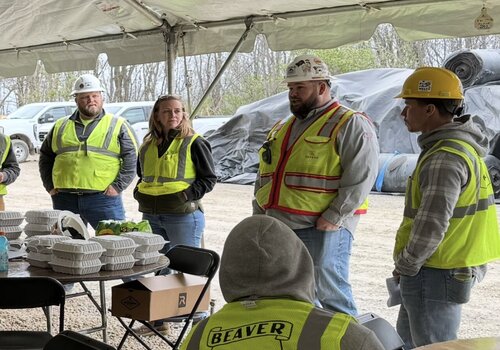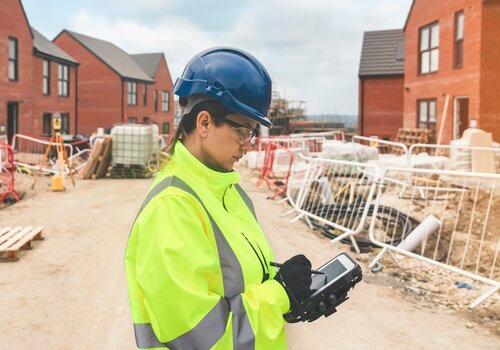Sustainability used to sound like something only large companies could achieve; but, as 2026 approaches, a transformation is happening across the construction industry. Small and mid-size contractors are finding practical, low-cost ways to be more sustainable, one decision at a time.
From reducing waste on jobsites to partnering with local suppliers, sustainable practices no longer come with big budgets. Here’s how to get started on your sustainability journey today.
WHY SUSTAINABILITY IS SMART BUSINESS
The construction industry produces roughly 600 million tons of waste each year, according to the U.S. Environmental Protection Agency (EPA). Yet the same report shows that a large portion of that waste like concrete, wood, metal and asphalt can be recycled or repurposed at a lower cost than sending it to landfills.
For small and mid-size firms, that’s an opportunity. Reducing waste cuts disposal fees, improves efficiency and shows clients you’re serious about stewardship. It also appeals to the growing number of project owners and municipalities requiring sustainability tracking in bids.
Low-cost strategies that you can start onsite:
• Plan materials carefully. Order what you need when you need it to minimize offcuts and returns.
• Reuse and recycle. Many regional recycling centers now accept clean wood, drywall and concrete; often at a fraction of landfill costs.
• Switch to LED lighting and efficient generators. Small upgrades save thousands in fuel and maintenance annually.
• Reduce idling. Even modest enforcement of anti-idling rules can save hundreds of gallons of fuel each year.
SOURCE LOCAL, BUILD LOCAL
Sustainability isn’t only about carbon; it’s also about community. Choosing local suppliers shortens transport routes, reduces emissions and keeps money circulating within your region.
According to the American Independent Business Alliance, every dollar spent at a local small business generates up to four times more economic impact than spending with national chains. For construction firms, that means buying from local quarries, rental houses and fabrication shops whenever possible.
Even small contractors can formalize this approach by developing a “local first” purchasing policy or adding a “community sourcing” section to bids. It signals alignment with clients’ sustainability values and can strengthen proposals for public or green-certified projects.
RETHINK TRANSPORTATION AND EQUIPMENT
Heavy equipment and fleet vehicles remain the largest contributors to a contractor’s carbon footprint and is also one of the ripest areas for small improvements.
Ideas to try in the new year:
• Regular maintenance: Clean filters and properly inflated tires reduce fuel use by up to 10 percent.
• Shared fleet usage: Coordinate across crews to maximize equipment hours per gallon.
• Hybrid or electric tools: Many manufacturers now offer battery-powered compact equipment and handheld tools that perform comparably without fuel costs.
• Renting versus buying: Equipment manufacturers are rapidly expanding rental-ready electric and hybrid models, making it easier for smaller firms to experiment without purchasing outright.
ENGAGE YOUR CREW FOR REAL CHANGE
Your workforce can be your strongest sustainability engine. Younger craft professionals overwhelmingly value employers who build with purpose and embrace sustainability. Engaging crews in sustainable initiatives help attract and retain that next generation of talent.
Ideas to engage your crew:
• Make it fun. Launch a “Sustainable Ideas Challenge,” rewarding crews for suggesting waste reduction or efficiency improvements.
• Train and inspire. Hold toolbox talks about recycling, idling and proper disposal.
• Celebrate wins. Publicly recognize crews that achieve sustainability goals.
MAKE SUSTAINABILITY PART OF YOUR STORY IN 2026
The year ahead will see tighter sustainability expectations from clients and regulators alike. The companies that thrive won’t necessarily be the biggest, but they must be the most adaptable.
How to share your sustainability journey:
• Share your story: Post before-and-after waste metrics, share supplier partnerships and highlight the human side: who benefited, what changed and how your company learned from it.
• Go above and beyond. Consider including sustainability outcomes in project close-outs, even if they weren’t contractually required. This habit not only builds internal accountability but also gives your company a ready-made portfolio of success stories for future proposals.
• Connect with your community. Sustainability doesn’t have to be an expensive campaign; it can be a community effort. Donating excess materials to local trade schools, planting trees near jobsite completions or supporting habitat restoration near infrastructure projects are small gestures that carry big meaning.
These initiatives humanize your company’s footprint and deepen relationships. Small and midsize contractors who focus on everyday efficiency, workforce engagement and community connection can increase sustainability in the year ahead with the budget they already have.
Connect with leaders in the industry about the unique needs of small business owners at CONEXPO-CON/AGG 2026 during the one-day Small Business Workshop and check out the Sustainability education session track.
Photo Credit: VOLVO












